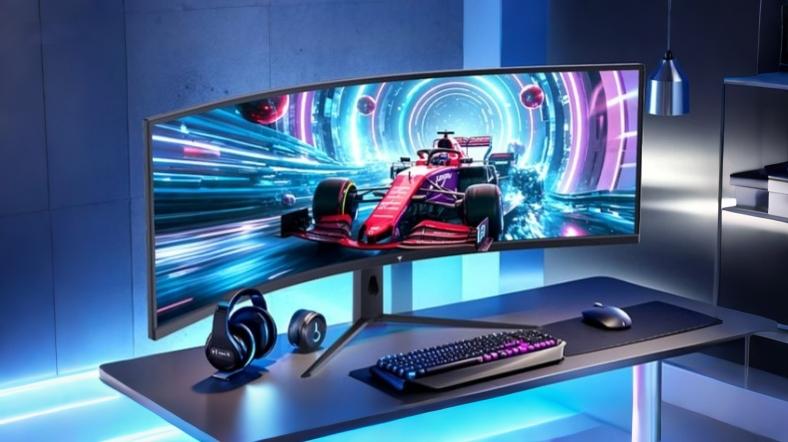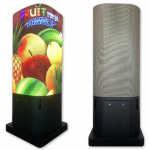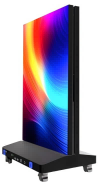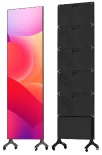From Pixels to the Whole Screen: Understanding the Decisive Role of 120Hz Refresh Rate in LED Direct-View Displays

In the LED display industry, two numbers are often mentioned: 7680Hz and 120Hz. Many assume they represent the same dimension of refresh rate, but in fact, they refer to completely different aspects of LED display technology:
- 7680Hz — the pixel-level refresh rate (PWM frequency) controlled by the driver IC. It determines whether the image remains flicker-free and maintains high picture quality at high brightness and low grayscale levels.
- 120Hz — the screen-level refresh rate, which directly impacts motion smoothness, frame stutter, and whether modern high-frame-rate content can be displayed correctly.
For video playback, 120Hz already delivers a noticeable improvement in clarity and smoothness compared to 60Hz. But in the gaming industry, the importance of 120Hz is absolutely decisive.
Why is 120Hz Refresh Rate So Critical for Gaming?
- Smooth Motion for Competitive Gaming
Gamers, especially in eSports, demand seamless performance. A 60Hz LED display struggles with motion blur in fast scenes, while a 120Hz LED display dramatically reduces image tearing and ghosting. - Low Latency for Real-Time Response
Gaming is not just about “watching visuals” but about human–machine interaction. A 120Hz gaming LED display delivers more frames per second, reducing input-to-screen response time—critical for FPS, racing, and fighting games. - Immersive Experience in XR and AR
In VR (virtual reality), AR (augmented reality), and XR immersive LED display environments, 120Hz prevents motion sickness and provides a more realistic, deeply engaging experience.
Why 7680Hz Pixel Refresh ≠ 120Hz Screen Refresh
Many ask: since LED displays can reach 7680Hz pixel refresh rates, doesn’t that mean they automatically support 120Hz screen refresh? The answer is no.
- 7680Hz ≠ 120Hz
7680Hz represents pixel-level PWM stability, ensuring flicker-free performance.
120Hz refers to the entire screen’s frame rate, requiring end-to-end synchronization across the display system. - System-Level Challenge
To achieve true 120Hz LED screen performance, multiple hardware and software components must work in harmony:- Driver ICs must support high-frame-rate data transfer
- Receiving cards & video processors need to handle 120Hz input/output
- Power supply & PCB design must sustain higher switching speeds and data throughput
- LED chips must respond consistently and stably
Only when these elements are fully optimized can an LED direct-view display deliver true 120Hz refresh rate performance.
Comparison: 7680Hz Pixel Refresh Rate vs 120Hz Screen Refresh Rate
| Metric | 7680Hz Pixel Refresh Rate | 120Hz Screen Refresh Rate |
|---|---|---|
| Definition | PWM frequency of pixel-level refresh | Frame rate of the entire screen |
| Impact | Stability, flicker-free, low grayscale rendering | Motion smoothness, real-time responsiveness |
| Use Case | Outdoor LED billboards, HDR playback | Gaming, XR production, immersive LED displays |
| Key Factors | LED driver IC | Driver IC, receiving card, processor, power, LED chips |
| User Perception | “Cleaner images” | “Smoother visuals” |
| Gaming Relevance | Foundational requirement | Decisive experience factor |
Conclusion
In LED direct-view display technology, 7680Hz is the foundation, but 120Hz is the true game-changer.
In applications such as gaming LED displays, XR studios, esports arenas, and immersive entertainment, 120Hz directly determines:
- Whether motion is smooth,
- Whether controls feel instantaneous,
- Whether the experience feels truly immersive.
7680Hz keeps the image stable, but 120Hz makes the image come alive.
For manufacturers of high-end LED display solutions, prioritizing 120Hz refresh rate and ensuring system-wide collaboration is essential to meet the demands of the next generation of high-frame-rate content.
























This image illustrates the critical role of 120Hz refresh rate in LED direct-view displays, emphasizing system-level collaboration of driver ICs, receiving cards, power supply, and LED chips. It compares high pixel-level refresh rates such as 7680Hz with screen-level refresh rates of 120Hz, demonstrating superior motion smoothness, low latency, and immersive experiences for gaming, esports arenas, and XR applications. Optimized for SEO with keywords including 120Hz LED display, 7680Hz pixel refresh rate, gaming LED display solutions, esports LED video walls, and XR immersive LED technology.
Core Difference Between Screen Refresh Rate and Pixel Refresh Rate
The core difference between **screen refresh rate** and **pixel refresh rate** lies in their **object of measurement** and **dimension of evaluation**. The former refers to the update frequency of the entire screen image, while the latter refers to the update frequency of a single pixel’s brightness or color.
### 1. Screen Refresh Rate
* **Definition:** The number of times per second that the screen displays a complete new image, measuring the overall speed of image updates.
* **Unit:** Hz (Hertz), e.g., 60Hz, 120Hz.
* **Function:** Determines the **smoothness of motion**, particularly for dynamic scenes such as games or videos. For example, a 120Hz refresh rate means the screen refreshes 120 independent frames per second, reducing motion blur and making moving images appear more fluid compared to 60Hz.
* **Associated Components:** Directly related to screen driving schemes and display controllers, and represents the **refresh rate perceived by users**, such as the 120Hz label on smartphones or monitors.
### 2. Pixel Refresh Rate
* **Definition:** The number of times per second that a single pixel updates its brightness or color, measuring the response speed of individual pixels.
* **Unit:** Usually Hz, sometimes expressed as updates per second.
* **Function:** Determines **pixel response accuracy**, affecting image clarity (especially in static frames) and color transition speed. A high pixel refresh rate allows pixels to quickly follow frame changes, avoiding “ghosting” (e.g., when pixel brightness does not dim quickly enough, causing trailing effects).
* **Associated Components:** Closely related to LED chip performance (e.g., electron migration speed) and packaging technology. It is a **hardware-level specification**, typically not labeled for end users and usually found in technical datasheets.
### Core Relationship
* **Pixel refresh rate is the foundation of screen refresh rate:** Only when individual pixels can update quickly (high pixel refresh rate) can the screen achieve a high overall frame refresh rate. If pixel refresh rate is insufficient, even a high screen refresh rate label may result in stuttering or ghosting.
* **Practical application:** Both must match. For instance, a screen with a 120Hz refresh rate typically requires a pixel refresh rate **well above 120Hz** (e.g., 3840Hz or 7680Hz) to ensure each pixel can complete the necessary brightness/color updates for 120 frames per second, preventing frame skipping or visual tearing.